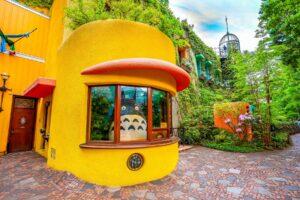Fodor's Expert Review Toshogu Nikko Shrine
With its riot of colors and carvings, inlaid pillars, red-lacquer corridors, and extensive use of gold leaf, this 17th-century shrine to Ieyasu Tokugawa is one of the most elaborately decorated shrines in Japan.
The Hon-den (Main Hall) of Toshogu is the ultimate purpose of the shrine. You approach it from the rows of lockers at the far end of the enclosure; here you remove and store your shoes, step up into the shrine, and follow a winding corridor to the Oratory (Hai-den)—the anteroom, resplendent in its lacquered pillars, carved friezes, and coffered ceilings bedecked with dragons. Over the lintels are paintings by Tosa Mitsuoki (1617–91) of the 36 great poets of the Heian period, with their poems in the calligraphy of Emperor Go-Mizunoo. Deeper yet, at the back of the Oratory, is the Inner Chamber (Nai-jin)—repository of the Sacred Mirror that represents the spirit of the deity enshrined here. The hall is enclosed by a wall of painted and carved panel screens; opposite... READ MORE
With its riot of colors and carvings, inlaid pillars, red-lacquer corridors, and extensive use of gold leaf, this 17th-century shrine to Ieyasu Tokugawa is one of the most elaborately decorated shrines in Japan.
The Hon-den (Main Hall) of Toshogu is the ultimate purpose of the shrine. You approach it from the rows of lockers at the far end of the enclosure; here you remove and store your shoes, step up into the shrine, and follow a winding corridor to the Oratory (Hai-den)—the anteroom, resplendent in its lacquered pillars, carved friezes, and coffered ceilings bedecked with dragons. Over the lintels are paintings by Tosa Mitsuoki (1617–91) of the 36 great poets of the Heian period, with their poems in the calligraphy of Emperor Go-Mizunoo. Deeper yet, at the back of the Oratory, is the Inner Chamber (Nai-jin)—repository of the Sacred Mirror that represents the spirit of the deity enshrined here. The hall is enclosed by a wall of painted and carved panel screens; opposite the right-hand corner of the wall, facing the shrine, is the Kito-den, a hall where annual prayers were once offered for the peace of the nation.
Behind the Inner Chamber is the Innermost Chamber (Nai-Nai-jin). No visitors come this far. Here, in the very heart of Toshogu, is the gold-lacquer shrine where the spirit of Ieyasu resides—along with two other deities, whom the Tokugawas later decided were fit companions. One was Toyotomi Hideyoshi, Ieyasu's mentor and liege lord in the long wars of unification at the end of the 16th century. The other was Minamoto no Yoritomo, brilliant military tactician and founder of the earlier (12th-century) Kamakura Shogunate (Ieyasu claimed Yoritomo for an ancestor).
Between the Goma-do and the Kagura-den (a hall where ceremonial dances are performed to honor the gods) is a passage to the Sakashita-mon (Gate at the Foot of the Hill). Above the gateway is another famous symbol of Toshogu, the Sleeping Cat—a small panel said to have been carved by Hidari Jingoro (Jingoro the Left-handed), a late-16th-century master carpenter and sculptor credited with important contributions to numerous Tokugawa-period temples, shrines, and palaces. Climb the flight of 200 stone steps through a forest of cryptomeria to arrive at Ieyasu's tomb--worth it for the view of the Yomei-mon and Kara-mon from above.
The centerpiece of Toshogu is the Yomei-mon (Gate of Sunlight), at the top of the second flight of stone steps. A designated National Treasure, it's also called the Higurashi-mon (Twilight Gate)—implying that you could gape at its richness of detail all day, until sunset. And rich it is indeed: 36 feet high and dazzling white, the gate has 12 columns, beams, and roof brackets carved with dragons, lions, clouds, peonies, Chinese sages, and demigods, painted vivid hues of red, blue, green, and gold. On one of the central columns, there are two carved tigers; the natural grain of the wood is used to bring out the "fur." As you enter the Yomei-mon, there are galleries running east and west for some 700 feet; their paneled fences are also carved and painted with nature motifs.
The portable shrines that appear in the Toshogu Festival, held yearly on May 17–18, are kept in the Shinyo-sha, a storeroom to the left as you come through the Twilight Gate into the heart of the shrine. The paintings on the ceiling, of tennin (Buddhist angels) playing harps, are by Tan-yu Kano (1602–74).
Mere mortals may not pass through the Chinese Gate (Kara-mon), which is the "official" entrance to the Toshogu inner shrine. Like its counterpart, the Yomei-mon, on the opposite side of the courtyard, the Kara-mon is a National Treasure—and, like the Yomei-mon, is carved and painted in elaborate detail with dragons and other auspicious figures.
READ LESS








